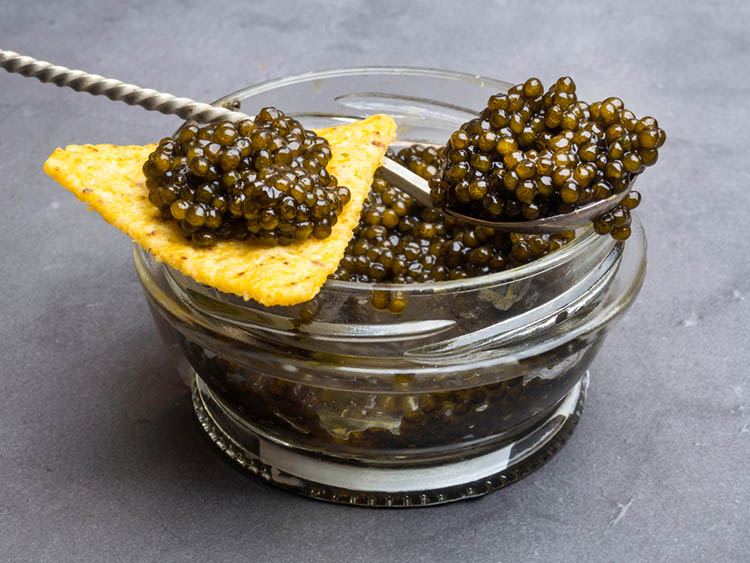Table of Contents
Types of Caviar
Although some people refer to any fish egg as Caviar, the only true Caviar is harvested from the sturgeon species of fish. All other fish eggs should be referred to as roe. Today, many species of fish are used to produce high-quality roes marketed as Caviar. Among these, trout, salmon, and whitefish are the most popular for their roe.
While there are twenty-six species of Sturgeon, the four most valuable all live in the Caspian Sea. These four are the Beluga, Osetra, Sevruga, and Sterlet. Belugas, being the largest, can live for up to 150 years and weigh one ton. Many connoisseurs consider Beluga Caviar to be the best, which put excessive demands on the species. As of today, it is illegal to import Beluga caviar into the US and also illegal to transport any remaining Beluga caviar that is in the US across state lines.
The roe of the Osetra has a slightly stronger flavor than the Beluga, but it is the Sevruga roe that tastes the strongest, along with producing the smallest eggs. The smallest sturgeon, the Sterlet, has larger roe than the Sevruga, but a mild taste. Because the Sterlet was prized as a food source, it was fished almost to extinction.
Serving Caviar
When enjoying Caviar, make sure to just relax and not overcomplicate the experience. To allow the delicate flavor of the caviar to come through, serve the caviar on a plain base, such as the traditional buckwheat blini. Plain crackers, toasted brioche, or challah bread are all perfect substitutes. You can then top with a small dollop of crème Fraiche on the blini, then add the caviar. For the purist, just enjoy the caviar by the spoonful will no adornment, pressing the eggs against the roof of your mouth with your tongue until they pop.

On the subject of serving Caviar, never use metal. The delicate nature of Caviar is so fragile that using a metal bowl or spoon will give the caviar an “off” flavor of a metallic tang. In haut cuisine, Caviar should be served in a bowl made of ice with a pearl or bone spoon. If you don’t have the luxury of such serving wear, the glass will work fine. If all else fails, use plastic before you ever consider using metal serving ware.
Fish may shine though with a squirt of lemon, but do not apply acidic liquids to caviar, as this can neutralize any flavor you’ve paid for.
Storing Caviar at Home
Caviar should be stored in the refrigerator, with the tin placed in a bowl of ice. Although you may not think so, your refrigerator is actually too hot to adequately store caviar. That being said, caviar should never be frozen. An unopened tin will stay fresh for two weeks, but once opened it should be consumed in two to three days.
Sustainable Caviar
Although long considered a luxury item, reserved for a lucky few, demand for Caviar has actually led to overfishing. Coupled with pollution of the Caspian sea in which most sturgeons make their home, many caviar companies are looking to sustainable fishing practices to supply their customers.
igourmet.com works with Tsar Nicoulai to offer a full range of sustainable caviar. Tsar Nicoulai is a leader in sustainable sturgeon production. Using proprietary tank-farming methods, they have significantly reduced the pressure on declining wild stocks. Coupled with water from natural aquifers and recycling programs, they truly are offering a “Green” alternative to the luxury of caviar.
The sturgeon tank water later filtered through a four-acre hydroponic vegetable pond. These vegetables are harvested year-round, and the plants then revitalize and clean the waters so the sturgeons can live in the most nutrient-rich environment possible. All this leads up to creating the best caviar possible. To find the best gourmet foods and gift baskets online, begin your search at igourmet.com.

